Finavarra House
Houses within 15km of this house
Displaying 49 houses.
Houses within 15km of Finavarra House
Displaying 49 houses.
| House name | Description | |
|---|---|---|
| Normangrove | In the 1850s the house at Normangrove, in the Kinvara area, was being leased by John O'Hara to Charles Higgins. In 1814 it had been recorded as the residence of John Burke and was also listed as a Burke house by Lewis in 1837. In 1906 Miss M.L. Forster held over 500 acres of untenanted land here as well as buildings valued at almost £3. The Forsters had held land at Normangrove at the time of Griffith's Valuation but no buildings. O'Connell states that the house was occupied until about 1914 and it fell into ruin therafter. The entrance and driveway lead to a farmyard and there is no trace of the house now. | |
| Doorus House | Dooras House was built by the French family in the 18th century. At the time of Griffith's Valuation Count de Basterot was leasing this property from Henry Comerford. In 1906 Count de Basterot was the owner of a mansion house valued at £10 here. O'Connell records that the house was demolished about 1917-18. | |
| Newtown Lynch | O'Connell states that Newtown was built around 1795. At the time of Griffith's Valuation the townland of Doorus Park was part of the estate of Patrick Lynch of Renmore. John W. Lynch is recorded as the owner of this mansion house, valued at £13, in 1906. On the Ordnance Survey maps it is labelled Newtown House. It has been in ruins since the 1930s. |

|
| Northampton | The townland of Poulnaveigh otherwise Northampton, containing Northampton House, "of modern construction", was offered for sale in the Encumbered estates court in June, 1865. In 1894 Slater refers to Northampton as the residence of Captain Harry de Vere Pery a son of the second Earl of Limerick. In 1906 it was the property of James Brady-Murray and was valued at £31. Northampton House is no longer extant having been demolished in the 1930s. http://www.northamptonns.com/index.php/eng/content/view/full/131 |

|
| Seapark House | This property is described as a caretaker's house on Christopher St. George's estate at the time of Griffith's Valuation when it was valued at £8. O'Connell states that it was locally known as "Foy's House" and was used as a fever hospital during the famine. It is now in ruins. |
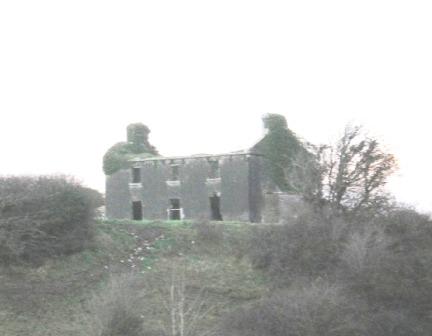
|
| Hermitage or Neptune | O'Connell states that this house was originally built by Dr. Nicholas Archdeacon, probably about 1805-6. It was later the property of the Blake family and in 1862 the house was known as Hermitage House and was the residence of Francis Blake Forster. It has been in ruins since the mid-20th century. |
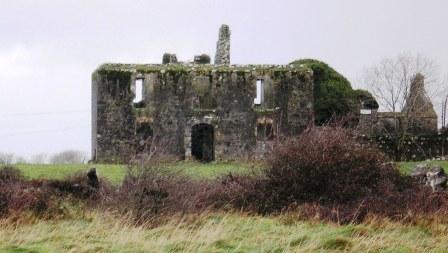
|
| Ardfry | Lewis mentions the seat of Lord Wallscourt in the parish of Oranmore but refers to it as Wallscourt rather than Ardfry, which is actually located in the parish of Ballynacourty. The Ordnance Survey Name books mention it as Ardfry House, the residence of Lord Wallscourt At the time of Griffith's Valuation it was being leased by the trustees of Lord Wallscourt's estate to Pierce Joyce when it was valued at £60. The house was built in the late 18th century and altered in 1826. The seat of Lord Wallscourt in 1894 and in 1906. It has been in a derelict state since the mid-20th century. In 2006 it was offered for sale as part of a scheme to create luxury apartments in the building. |

|
| Rinville House | Lewis records the house at Rinville as the seat of T.L. Athy in 1837. Earlier in 1814 it was the residence of Phillip Athy. At the time of Griffith's Valuation it was valued at £48 and was occupied by Randal Athy. A second property in the townland of Rinville West was leased by the Athy estate to Patrick Blake. In 1906 Rinville was owned by Edmond J. Athy and was valued at £43. It is now an ivy covered ruin. Part of the demesne lands are a public park maintained by Galway County Council. A gate lodge is still extant but unoccupied. A graveyard for the Oranmore area has been established on part of the demesne lands. |
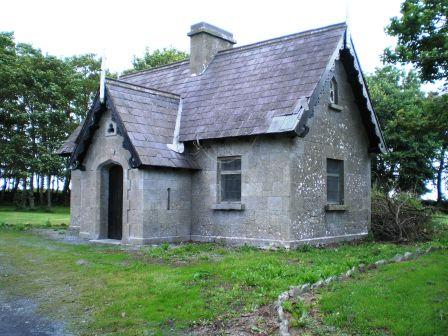
|
| Cottage (Dunkellin) | In 1837 Lewis recorded Cottage as the seat of J. Ryan. Catherine Ryan was leasing the house from Randall Athy at the time of Griffith's Valuation when it was valued at £17. The house at Cottage was part of the Athy estate which was sold in the Encumbered Estates court in July 1857. The new owners, John Edmond Crofton Kelly and Edmond Walker Kelly offered it for sale again in June 1866. At this time the house at Cottage was leased to the representatives of Thomas Redington for 21 years from 1856. By 1906 it was owned by Charles V. Pratt together with 150 acres of untenanted land. The ruins of the house and other buildings are visible at the site. |

|
| Prospect Hill | At the time of Griffith's Valuation the house and buildings at Prospect Hill were in the ownership of Lord Wallscourt's trustees and were valued at £21. Earlier, the Ordnance Survey Field Name Books mention Mr. Dawson of Prospect, as the agent to the Wallscourt estate. There is still a house at the site but it is not the original one. |

|
| Seafield | Seafield House is no longer extant though evidence of walled gardens and out buildings are still visible. It was the residence of Robert Blake in 1814. In 1824 it was the residence of Henry Blake who offered it for letting in the ''Connaught Journal'' in May of that year. The Ordnance Survey Field Name Books noted Seafield as the residence of Mr. Blake's steward. At the time of Griffith's Valuation it was leased by the Blake estate to Matthew Fynn and was valued at £6. | |
| Furzepark House | This house is noted on the 1st editon OS Map as Furze Park House but it may later have been known as Seafort House. The Ordnance Survey Name books describe it as a "bathing lodge, belonging to Mr. J. Smith, Loughrea". It was leased by the Blake estate to Martin Morris at the time of Griffith's Valuation when it was valued at £9. By 1906 the buildings owned by Lord Wallscourt at Treanlaur were valued at almost £2. Substantial ruins of this house are still visible. |

|
| Tyrone | Tyrone was built in the early 19th century. It is described in the OS Name Books as "a beautiful residence" in the 1830s. At the time of Griffith's Valuation, it was in the possession of Christopher St.George and was valued at £50. In 1894 Slater notes it as the seat of Robert J.K. St.George. The family ceased to live there in the early twentieth century. Its ruins can be seen overlooking the estuary of the Clarin river. |

|
| Furbogh House | At the time of Griffith's Valution, Andrew Blake held this property in fee when it was valued at £34. Furbough was demolished in the later twentieth century. The remains of the walled garden are still visible. |
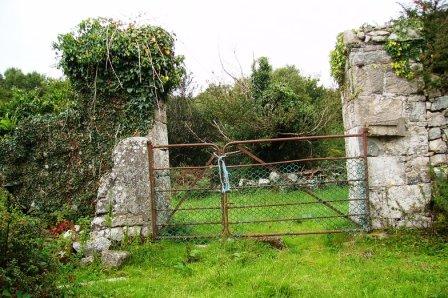
|
| Lenaboy Castle | This property was held in fee by James O'Hara at the time of Griffith's Valuation when it was valued at £40. In 1786 Wilson refers to a house at Galway which was the seat of Geoffrey O'Hara. Bence Jones describes the house as Tudor Gothic, early to mid 19th century, while the National Inventory of Architectural Heritage notes that the current building is dated 1859. It is now a Health Services facility. |
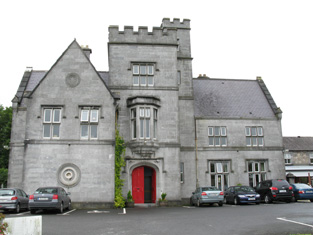
|
| Cloghballymore | Originally a tower house owned by the Kilkelly family, Cloghballymore House, was extended a number of times by the various families who held the estate over three centuries.. The National Inventory of Architectural Heritage indicates that the main house at the site was constructed by Marcus Lynch in the eighteenth century. In 1906 it was owned by Llewellyn Blake and was valued at £18. It was later given by him to a missionary order and maintained for some time as a seminary. The building is still extant and now used as St. Columba's nursing home. |
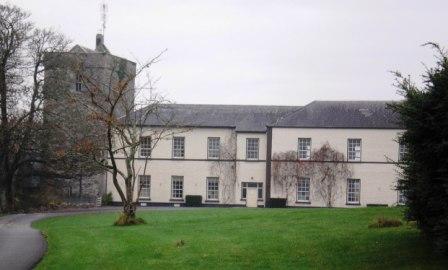
|
| Ballyclery | The house at Ballyclery is described as a caretaker's house for the St.George estate. It was valued at £8 in 1855. An occupied house still exists at this site but may have been modernised. | |
| Stradbally | Griffith's Valuation shows that Christopher St.George had what are described as "offices" valued at £16 in the townland of Stradbally West, parish of Stradbally, barony of Dunkellin. This was the stable complex for Tyrone House and adjacent to the walled garden which was part of the estate. |

|
| Seamount Lodge | The Clanmorris family had a residence in the Salthill area of Galway at Pollnarooma East parish of Rahoon, leased from Richard Sloper. It was valued at £21 at the time of Griffith's Valuation. A house named Seamount Lodge is marked on the first Ordnance Survey map in this townland. Seamount was the home of Sebastian Nolan of the Ballinderry family in the late 19th century. It was in use as a nursing home in the twentieth century before being demolished to make way for the housing estate of the same name. | |
| Barna | Wilson refers to Barna as the seat of Mr. Lynch in 1786. Nicholas Lynch held this property in fee at the time of Griffith's Valuation,when it was valued at £20. It was the seat of Marcus Lynch in 1894 and the family were still resident in the early 20th century. The house is still extant surrounded by an apartment development. |

|
| Newcastle | In 1786 Wilson refers to Newcastle as the seat of Thomas Browne. In the nineteenth century a Persse residence close to their distillery at Nun's Island and their milling operations. Newcastle House was the home of Henry Stratford Persse in the early 19th century. It was later acquired by University College, Galway but was demolished in the early 1970s to make way for new buildings. | |
| Nile Lodge | Nile Lodge is associated with the O'Hara family though at the time of Griffith's Valuation, it was leased by Edward C. Burke from Mark Lynch and valued at £35. It is still extant and occupied. |
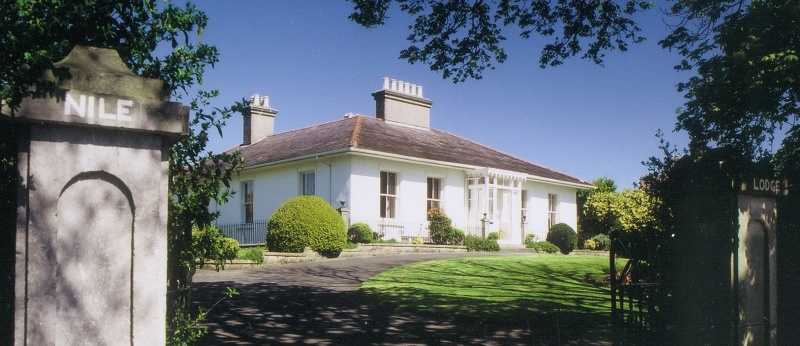
|
| Rahoon House | In 1786 Wilson refers to Rahoon as the seat of Mr. French. In the early 19th century it was a Bodkin house, occupied by Roderick O'Connor at the time of the first Ordnance survey. It was held in fee by Thomas C. Dickson at the time of Grifith's Valuation and valued at £27. This house was bought by Kennedy O'Brien in the early 1870s and remained in his family's possession until the 1930s. Buildings are still extant at the site. |
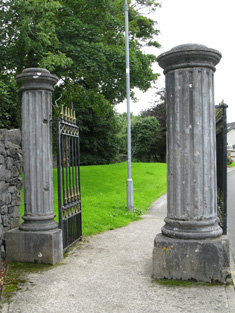
|
| Murroogh House | Part of the Blake estate at Merlin Park. Built by James Henry Ryan in the 1860s who spent nearly £5,000 on the property and occupied in the 1880s by the Bishop of Galway. Owned by the newspaper magnate William Randolph Hearst in the 1930s and bought by the Galway Mayo Institute of Technology in 2003. |
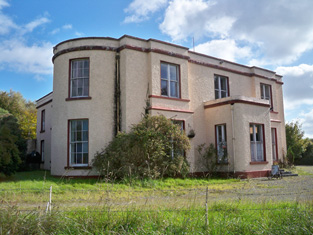
|
| Mount Vernon | The 1882 sale notice for the Burke estate mentions that Mount Vernon cost over £5000 to build a short time before. | |
| Roo | The original Roo House was a single story L-shaped building. Only a small portion, which has been incorporated into farm buildings, now remains. Tradition indicates that it was leased by Bishop Nicholas Archdeacon sometime in the early 19th century. In the 1830s it was the residence of a Mr. Sellers. The house and over 100 acres was leased by the Curtin family from the Gregory estate in the 1840s but the Gregorys were later obliged to sell this part of the estate. A two-story house, now derelict, was erected on the site in the early 20th century. The property is still held by the Curtin family. |

|
| Glenarde | Town house of the Persse family, built in the mid 19th century, bought by the Bolands of Bolands biscuits in the 1920s and since the early 1960s has functioned as the Ardilaun House Hotel. |

|
| Rineen | The property at Rineen was leased to Daniel O'Dea by Henry Comerford at the time of Griffith's Valuation. It was valued at £26 and included a mill. The National Inventory of Architectural Heritage suggests it was built c.1804 by Count de Basterot. It is now a ruin. |
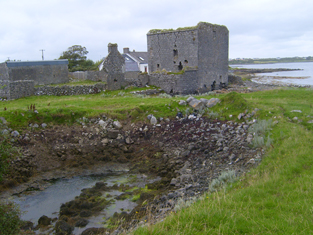
|
| Seamount | Seamount House was built by the Butlers of Cregg in the 18th century. O'Connell notes that Seamount was the residence of Maj. Theobald Butler, who had fought at the Battle of Waterloo, during the 1820s. At the time of Griffith's Valuation Denis Hynes was leasing from Edmund Donnellan, when it was valued at £16. Dr. Hynes had purchased the house from the Butler estate. In the early 20th century it was given to the Sisters of Mercy and is now a school. |

|
| Thornville Lodge | O'Connell states that this house was built by the Bricknell or Bucknell family in the later 18th century. It was later occupied by the Bishop of Kilmacduagh, Dr. Ffrench. Kinvara parish records also indicate that Arthur and Clare Ireland lived here in the 1830s. This may be the same Arthur Ireland who held the post of Burser at Queen's College, Galway in the 1850s. The house is still extant. | |
| Neptune Vale | O'Connell states that Neptune Vale was the original de Basterot house in the Kinvara area, probably built in the late 18th century. The house was demolished sometime in the mid-19th century although at the time of Griffith's Valuation, it was still owned by Count de Basterot and valued at £4. One of the outbuildings was possibly subsequently converted into a dwelling house. | |
| Doorus Cottage | O'Connell states that Doorus Cottage was built by the de Basterot family in the 1860s, possibly with materials from the demolished Neptune Vale. It had several owners before being given to An Oige in 1961 as a youth hostel. |

|
| Harbourhill Lodge | Marked as Habourhill Lodge on the first Ordnance Survey map, this house was occupied by the Reverend Michael O'Fea at the time of Griffith's Valuation and held from John Bindon Scott. It later became a Constabulary barracks, now a ruin. | |
| Corranroo Lodge | Occupied by Burton Bindon in 1837 and by Samuel Bindon in the mid 19th century, who held the property from Colonel Henry White with 11 acres. Weir writes that it was the home of the Misses Lloyd in the early 20th century, one a painter and the other a sculptress. The house is no longer extant. | |
| Newtown Castle | Newtown Castle was originally the home of the O'Loghlens of the Burren and Lewis records C. O'Loghlen resident there in 1837. By the time of Griffith's Valuation it was part of the estate of Colonel Henry White, later 1st Baron Annaly. The present house was a rectory at the time of Griffith's Valuation inhabited by Reverend Hugh B. Howlett. The original castle is still extant and the Burren College of Art is now located at this site. | |
| Fanore Lodge | This house was located on the O'Brien estate. Occupied by Richard Blood in 1814 and by Robert Johnston at the time of Griffith's Valuation, when it was valued at £5.10 shillings. Robert Johnston held the house and 950 acres from Jemima O'Brien. Weir writes that the house later became a police barracks. Buildings are still extant at the site. | |
| Mount Elva | Built in 1848, Pierce Creagh came to live here from Rathbaun. It was held in fee by him at the time of Griffith's Valuation, when the buildings were valued at £12 10s. The house is now a ruin. | |
| Mount Vernon Lodge | Marked on the first edition Ordnance Survey map this house belonged to William Joseph Skerrett who held it in fee at the time of Griffith's Valuation. It later became the holiday home of Sir Hugh Lane's parents and then of Lady Gregory who entertained well known literary figures at the house. Mount Vernon is still extant and used as holiday accommodation. |
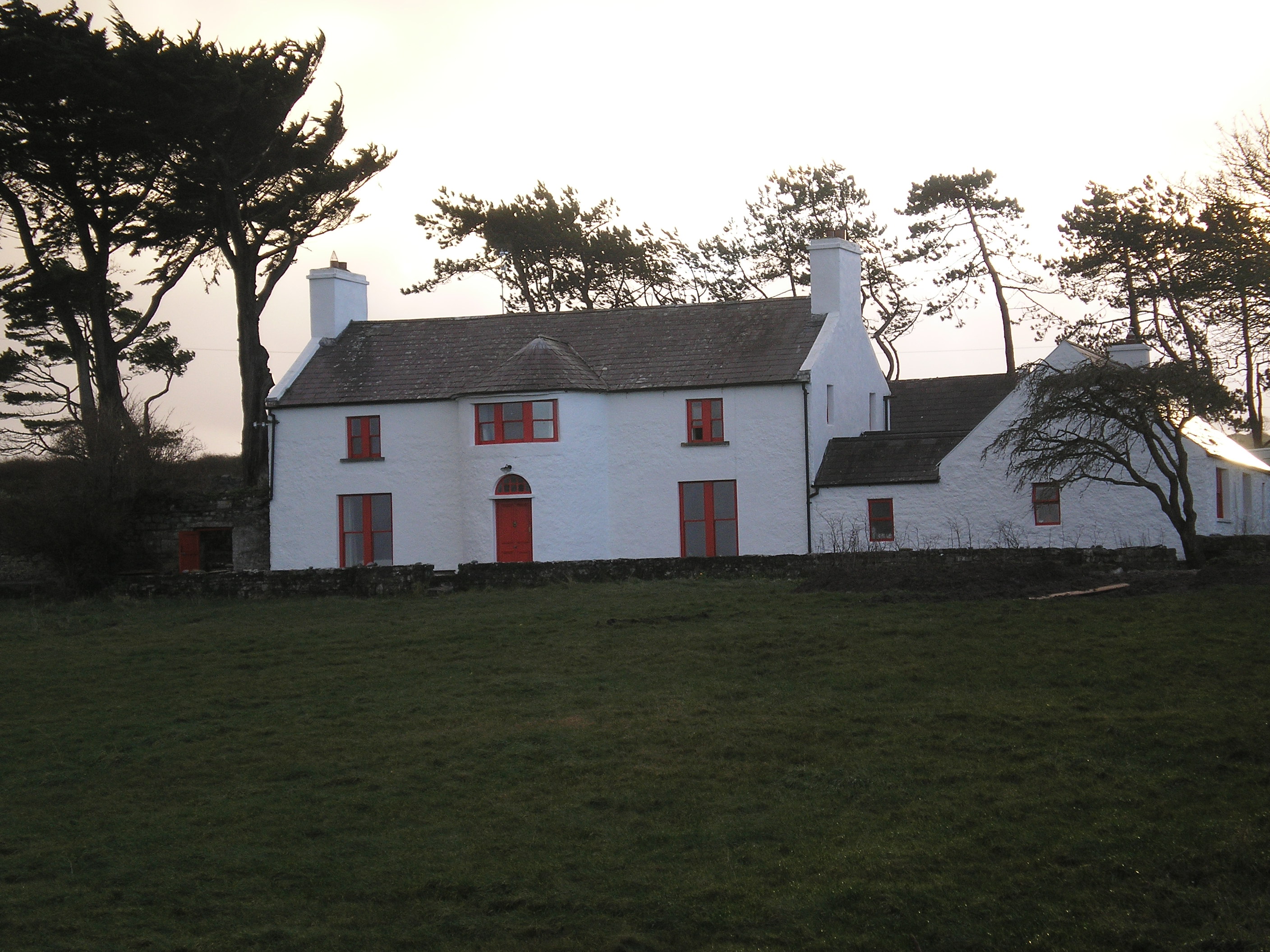
|
| Ballyallaban | Occupied by Michael O'Brien in 1814, J. O'Brien in 1837 and by Michael O'Brien at the time of Griffith's Valuation. The house and over 700 acres was held from Colonel Henry White. | |
| Gregans Castle/Cregans Castle | Gregans Castle/Cregans Castle The home of the Martyn family from at least 1837, now run as a hotel. Valued at £10.5 shillings at the time of Griffith's Valuation. |
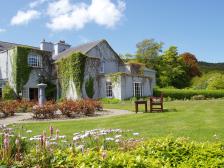
|
| Sans Souci | A seaside residence, occupied by the Reverend John Westropp in 1814 and 1837, rector of Ballyvaghan. It later belonged to the Comyn family, now demolished. |
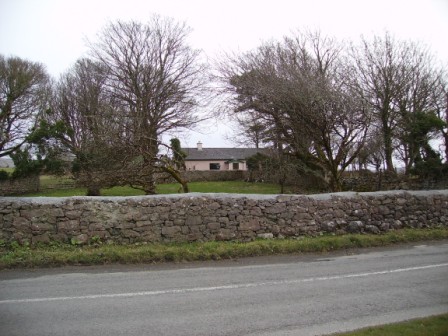
|
| Clareville | Weir writes that this house was built by a member of the Joynt family, one of whom was agent to the White estate in the early 19th century. It was valued at just over £5 and was unoccupied at the time of Griffith's Valuation. James and Michael Comyn were the immediate lessors who held over a hundred acres from Colonel Henry White. Clareville was one of the residences of William Lane Joynt in the latter half of the 19th century. An occupied house still exists at this site. |
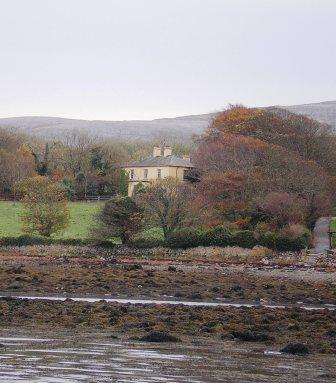
|
| Cartron | A 19th century house used as a summer residence by the Brady/Brady Browne family, now a ruin. | |
| Glencolumbkille House | This was an O'Brien home from at least the late 18th century. In 1837 Lewis described Columbkill Cottage as the "neat residence" of Terence O'Brien esq. Griffith's Valuation records Mary Anne O'Brien (the widow of Terence) as the occupier holding the property from John Kirwan. The buildings were valued at over £10. In the 1870s Morty O'Brien of Glencolumbkille owned 396 acres in county Clare. This is house is no longer extant. | |
| Delamaine Lodge | According to O'Connell, Delamaine Lodge was occupied by a Huguenot merchant, Captain William de la Maine, in the late eighteenth century. It was later owned by the de Basterort family and afterwards by the Gregory estate. It is still extant. |
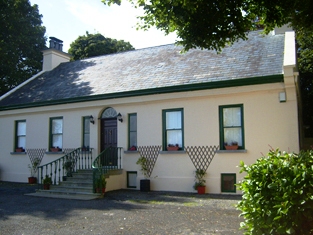
|
| Carrickmore House (Furbo) | A house built on land owned by Andrew Blake at the time of Grifith's Valuation. The National Inventory of Architectural Heritage suggests it was built c.1860. It was renovated in recent times. |
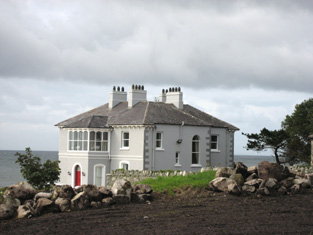
|
| Marino Cottage | This house, labelled Marino Cottage on the First Edition Ordnance Survey map,was vacant at the time of Griffith's Valuation, when it was part of the estate of Andrew Blake. It had a valuation of over £23 at that time. The house no longer exists, having been replaced in the twentieth century by the Connemara Coast Hotel complex. | |
| Kingston House (Galway) | Richard N. Somerville was the owner of over 70 acres in the county of the town of Galway in the 1870s. He was the owner of Kingston House at the time of Griffith's Valuation, when it was valued at £14 and was unoccupied. By the 1890s it was occupied by a religious order. | |
| Fort Eyre | At the time of Griffith's Valuation a property here, owned by Reverend E. Maunsell, was being leased by Richard A.H. Kirwan and was valued at £42. The house is labelled Fort Eyre on the 1st edition Ordnance Survey map. It is still extant. |
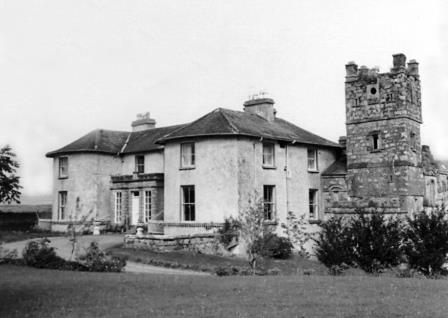
|

